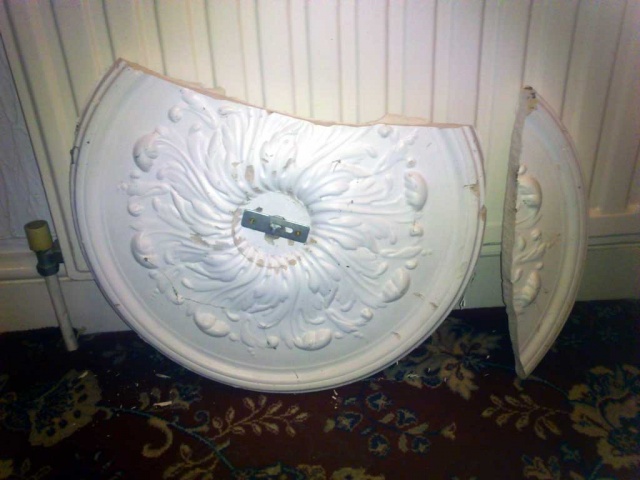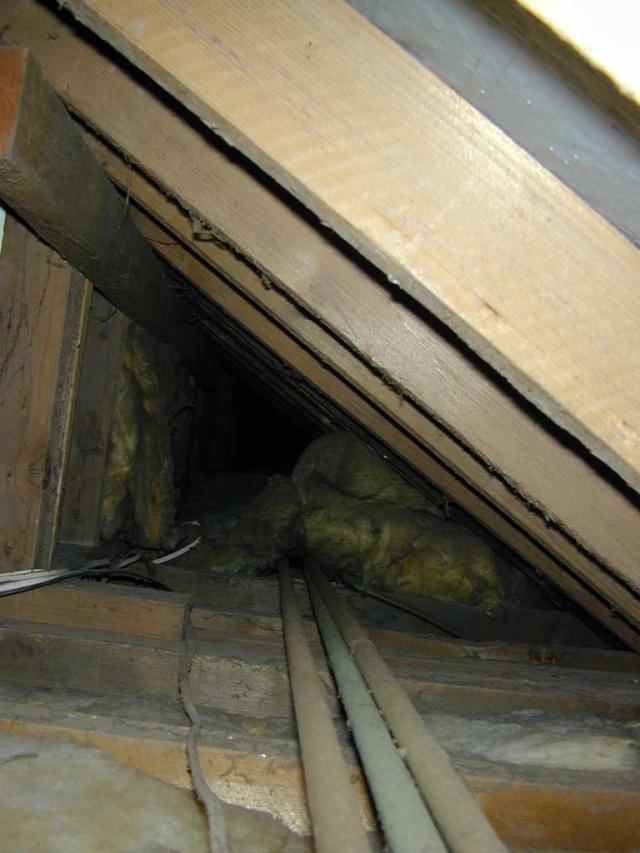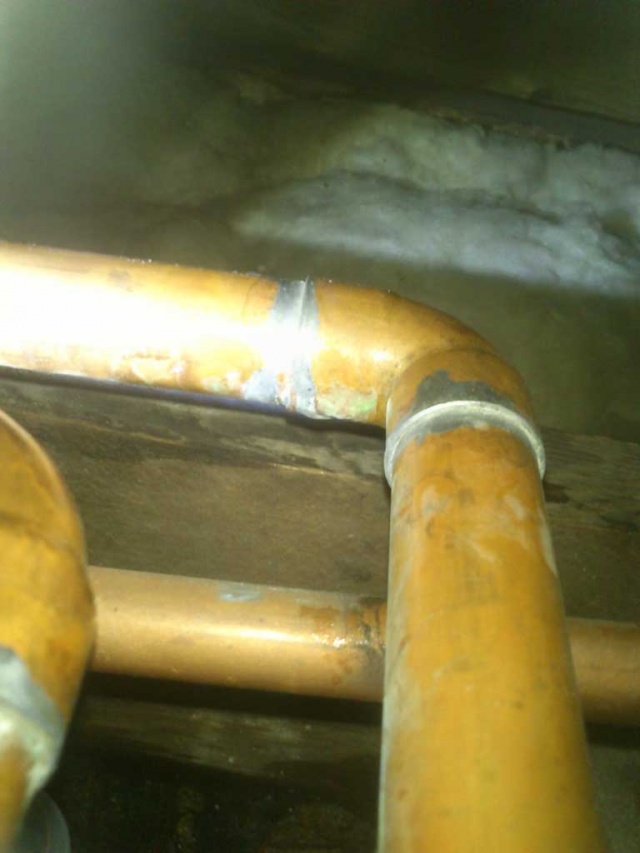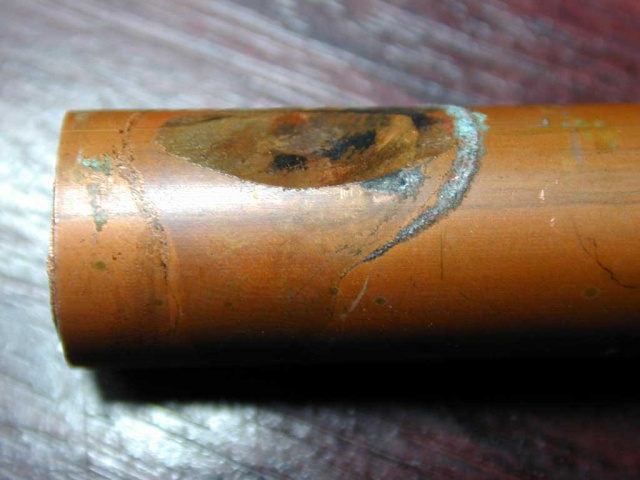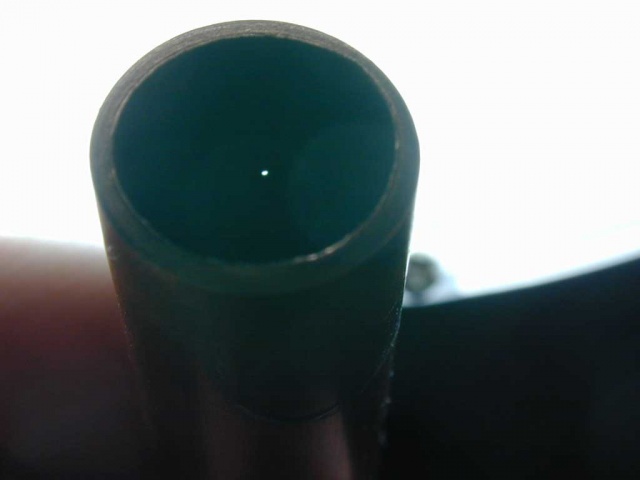Difference between revisions of "The tale of the rubbing pipe"
m (→Time for some pipe fixing: typo) |
m (→Time for some pipe fixing: typo) |
||
| Line 34: | Line 34: | ||
[[image:DishedPipe.jpg|640px]] | [[image:DishedPipe.jpg|640px]] | ||
| − | ...and managed to get a compression fitting in while working at arms length. That duly followed the law of compression fittings - i.e. they work first time every time apart from the very | + | ...and managed to get a compression fitting in while working at arms length. That duly followed the law of compression fittings - i.e. they work first time every time apart from the very rare occasions where it would be a real pain in the arse if they don't - so obviously, one end continued to weep just a tiny bit, but a tiny bit that would not lessen with tightening. You can guess where there nearest roll of PTFE wasn't! So another trek in an out was required to finally fix that. |
Later investigation showed the hole in the pipe was sub pin hole sized - in fact almost invisible to the eye: | Later investigation showed the hole in the pipe was sub pin hole sized - in fact almost invisible to the eye: | ||
Revision as of 15:49, 10 July 2013
Its somewhat difficult to know how to categorise this article, perhaps "tale of woe" or "what happens when you rub a couple of pipes together" might cover it....
Crash
To set the scene, its Easter Saturday and some friends have popped round for coffee. We are chatting in the kitchen, when there is a loud crash with the rather "expensive" sound of much breaking glass into the bargain. We set off to find the child / pet at the source of the disturbance, and instead find a rather sorry state in my office... a large light fixture (a five "armed" affair with a fluted glass at the end of each arm) lays in a mangled mess on the floor, in a large pile of what used to be glass shades and light bulbs! To add insult to the narrowly avoided injury, the substantial plaster rose that was previously fixed to the ceiling, seems to have accompanied the light fitting it on its day trip, and now lays on the floor looking rather bruised and battered:
Inspector Clouseau
After the initial thoughts of "that looks broken", one happens to notice a certain amount of water dripping out of the hole in the ceiling, and the general "soggyness" of the ceiling rose sized patch of plaster that is now rather conspicuous on the ceiling. This new fact is added to the mental database of "not good things" that seem to be rapidly accumulating.
Hence an investigation to find the source of river office, is launched - hopefully to reach a conclusion prior to the point where the rest of the ceiling decides to follow the light on its day trip!
Hunt the drip
A quick deployment of a large tarpaulin over the top of much computer equipment is next on the agenda, along with shutting off the water. Turning the power off to the light circuit that is now making an interesting crackling / sizzling noise is also considered prudent. Then the fun can really start!
The first problem is access. The office is on the ground floor, under a bedroom. The bedroom is in effect in the roof space of what was at one time a Victorian bungalow prior to its loft conversion at the hands of the previous owners. Nothing damp visible in the room above, which suggests the source must be either in the floor void, or coming from a leak in something near the eves of the house. Historically the eves space would have been inaccessible and voided off, however some time ago I had created a access way through into a section of the voided space to make use of it for storage. In theory is also allows access right along one side of the roof space. The "in theory" is based on:
While there are a couple of larger areas of space between dormers, the sections by each dormer window are somewhat more restrictive! Unfortunately the tall but skinny and obliging friend who had previously been tasked with intra roof exploration was not to hand. That meant me and my "brick outhouse" construction was going to have to go down there!
The culprit
Ten minutes of "bugger this is uncomfortable", making like an inch worm later, we find a rather soggy looking section of lath and plaster ceiling. No holes visible in the roof, so attention switches to the pipes. Above it is the rather innocent looking:
The top 22mm pipe is the main flow or return from the boiler - the 15mm below is the hot water feed to the kitchen. A check on the heating system prior to this little horizontal adventure showed that was still reporting 1.8 bar, so the suspect is the small one underneath rather than the heating pipe. A careful look showed drips of water tracking along the pipe and running off to the left under the dwarf wall of the dormer, and into the house - and we know where they were obviously falling off the pipe. Lifting the top pipe up, showed that it was actually resting on top of the small pipe, and once uncovered, a very fine and delicate fountain of water was revealed coming from the top surface of the pipe.
Time for some pipe fixing
There is only one thing worse than crawling head first into a long narrow space, and that is crawling out again backwards! Anyway, that done, taps turned on to drain the pipe, and the workshop raided for a pipe cutter, fittings etc, the return visit could be made. The initial plan was a compression fitting, since the space was rather too restricted to solder in comfortably. Its only after reaching the pipe for the second time, the voice in my head said "pushfit you bozo"! Still make do with what is to hand.
Chopped out the small bit of pipe:
...and managed to get a compression fitting in while working at arms length. That duly followed the law of compression fittings - i.e. they work first time every time apart from the very rare occasions where it would be a real pain in the arse if they don't - so obviously, one end continued to weep just a tiny bit, but a tiny bit that would not lessen with tightening. You can guess where there nearest roll of PTFE wasn't! So another trek in an out was required to finally fix that.
Later investigation showed the hole in the pipe was sub pin hole sized - in fact almost invisible to the eye:
Prevention rather than cure
Its hard to say how long it took for the pipe to wear through like that, but I would guess 20 to 30 years of thermal cycling of the pipe did it. A photo of the underside of the 22mm pipe showed no obvious damage to that, so it must have been "sawing" through the smaller one all or most of the the time (the 22mm pipe is probably a 8m to 10m straight run). Some thick walled foam pipe lagging was added to the crossover and any other likely rub points to prevent further problems.
So all that now remains is to let things dry out and stick the ceiling back together, and a light back up to replace the hastily erected pendant lamp holder dangling from wires in the ceiling.
